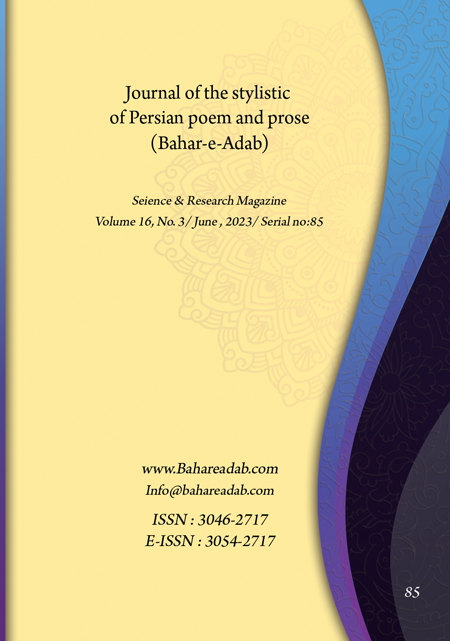- Count View : 371
- آدرس کوتاه شده مقاله: https://bahareadab.com/article_id/1460
- کد doi مقاله: Doi: 10.22034/bahareadab.2023 .16 .6895
Journal of the stylistic of Persian poem and prose
volume Number 16،
number In Volume 3،
،
issue Number 85
The search for Vasukht (withdrawing love) in the poetry of Sa’eb Tabrizi
Morteza Ghasemi (Author in Charge), Noushin Ghasemi
Abstract
BACKGROUND AND OBJECTIVES: Vasukht (withdrawing love) style as one of the branches of Voqou (Factual poetry) style in Persian literature in the second half of the 15th century and flourished in Iran until the middle of the first half of the 16th century. In this style, contrary to the old tradition of ghazal, the lover speaks harshly to the beloved, flatters and makes unnecessary excuses, and sometimes is heartbroken by the beloved. Although in the age of Saeb, this style was no longer popular in Iran but in Saeb"s poetry, themes of withdrawing love can be found, although in a small and scattered way, which shows that he was not unwilling to write such poems and he paid attention to the poems of withdrawing love. The present article tries to search and examine the term and poems of Vasukht (withdrawing love) in Saeb"s poetry as much as possible.
METHODOLOGY: The present research is a theoretical study based on library studies, and the scope of the research is the six-volume Diwan Saeb edited by Mohammad Ghahraman.
FINDINGS: In this article, by searching Diwan Saeb, we have introduced 20 ghazals and a significant amount of scattered verses with the content of withdrawing love, and we have divided and separated them into different categories based on the type of theme. We have also determined whether the audience of these poems is a general or special lover.
CONCLUSION: In Saeb"s poetry, " Vasukhtan " and its relatives are used at least 12 times, which shows Saeb"s interest in writing such poems. The themes of withdrawing love Saeb"s poems are: theoretical explanation Vasukht, warning, threat, condemnation, Failure to convert to a romantic relationship, rejection of former lover and falling in love with another. The theme of some poems indicates a real experience in Saeb"s life and poetry, but in most of them, no specific lover is mentioned.
Keyword
Sa’eb Tabrizi
, Ghazal of the16th and 17th centuries
, Voqou (Factual poetry) style
, Vasukht (withdrawing love)
, Sa’eb Tabrizi
- Anvari, Hasan. (2003). Sokhan Comprehensive Dictionary, Volume 8, Tehran: Sokhan.
- Aryanseresht, Zahra. (2010). “Traces of the withdrawing love (Vasukht) school in ten Iraqi style letters”, Journal of literary research (Islamic Azad University, Central Tehran branch), No.21, pp.165- 182.
- Bayat, Ali. (2012). “The background of the literary genre and its comparative study in Persian and Urdu literature”, Journal of Comparative Literature, No 3, pp. 74- 93.
- Fotoohi Rudmajani, Mahmood. (2014). “The style of Vasukht (withdrawing love) in Persian poetry (the leader of Vasukht is Mohtasham, not Vahshi-I Bafqi)”, Journal of namehfarhangestan, 3 No, pp. 7-34.
- Fotoohi Rudmajani, Mahmood. (2016). One hundred years of physical love; Voqou (Factual poetry) style and Vasukht (withdrawing love) in Persian poetry of the 10th century, Tehran: Sokhan.
- Golchin ma’ani, Ahmad. (1995). Voqou (Factual poetry) school in Persian literature, Mashhad: Ferdowsi University of Mashhad.
- https://www.iranicaonline.org/articles/saeb-tabrizi.
- KHadivar, Hadi and Faraji, Shima. (2014). “Footprint on the road of Persian poetry (from the Khorasani style to the rise in the form of an independent school)”, Journal of analysis and criticism of Persian language and literature texts, No. 21, pp. 55- 84.
- Mirsadeghi, Meymanat. (1997). A Dictionary of poetry and poetics, 2nd ed, Tehran: Ketab-e- Mahnaz.
- Natel-Khanlari, Parviz. (1992). Remembering Sa’eb, Sa’eb and Indian style in the scope of literary research, edited by Mohammad-Rasoul Daryagasht, Tehran: Qatreh.
- Razmjo, Turan. (2011), “An overview of the Vasukht (withdrawing love) school in the history of Iranian literature”, Journal of Ketab-e- Mah, No. 48, pp. 80- 84.
- Sa’eb Tabrizi. (1996). Diwan-I Sa’eb, ed Mohammad-I Ghahraman, 3rd ed, Tehran: Elmi- Wa Farhangi.
- Seraj al-Din Ali Khan AkbarAbadi. (1996). Chreagh aI- Hedayat Dictionary, Edit by Mansur Servat,2ed. Tehran: AmirKabir. (The explanation is that this book is printed together with Ghiyath-al-Laghat in one volume and Ghiyath-al-Laghat is written on the cover).
- Shafi’Kadkani, MohammadReza. (1987). The Poet of Mirrors: A Study of Indian Style and Beadel's Poetry, 12 th ed, Tehran: Agah.
- Shafi’Kadkani, MohammadReza. (1999). Persian literature from the Jami era to our time, Translation of Hojjatullah Asil, Tehran: Ney.
- Shamisa, Sirus. (1994). Ghazal course in Persian poetry, 4th ed, Tehran: Ferdos.
- Shamisa, Sirus. (1999). Poetry stylistics, 4th ed, Tehran: Ferdos.
- Shamisa, Sirus. (2002). Sodomy: based on persian literature, Tehran: Ferdos.
- Shebli No’mani. (1989). Sher-al-Ajam, translated by MohammadTaghi Fakhr Daei Gilani,3rd ed, Tehran: Donyaye Ketab.

